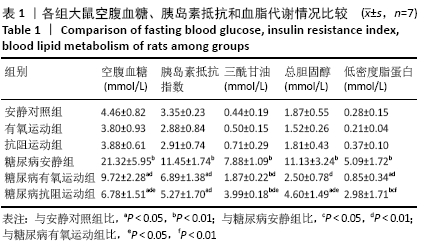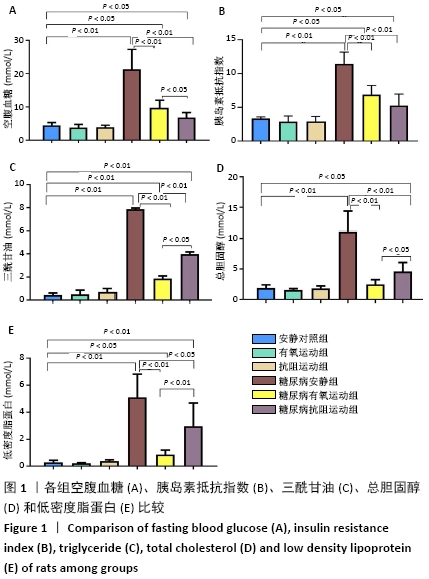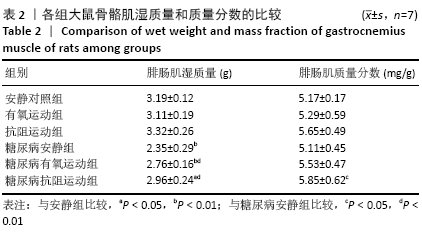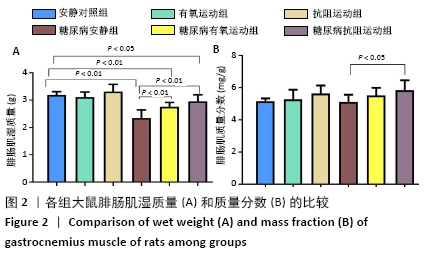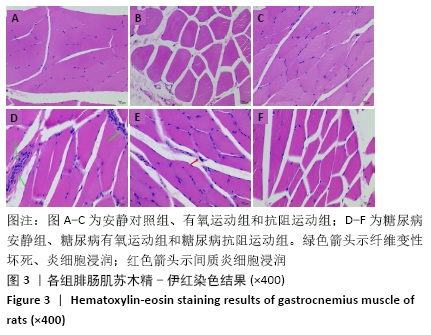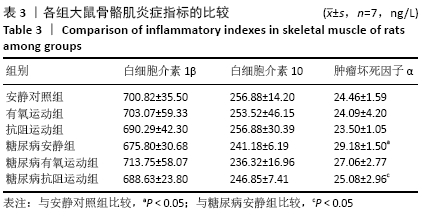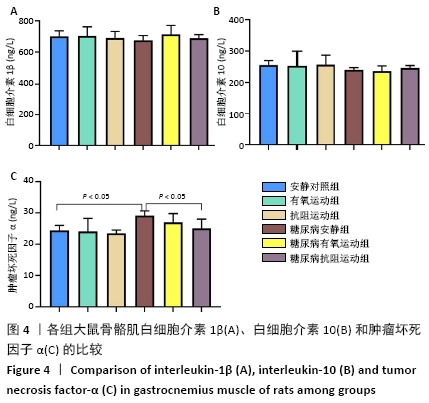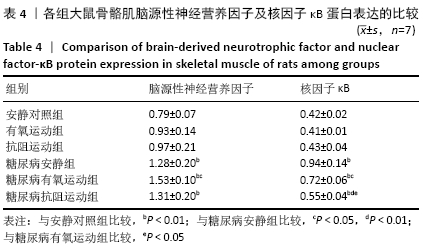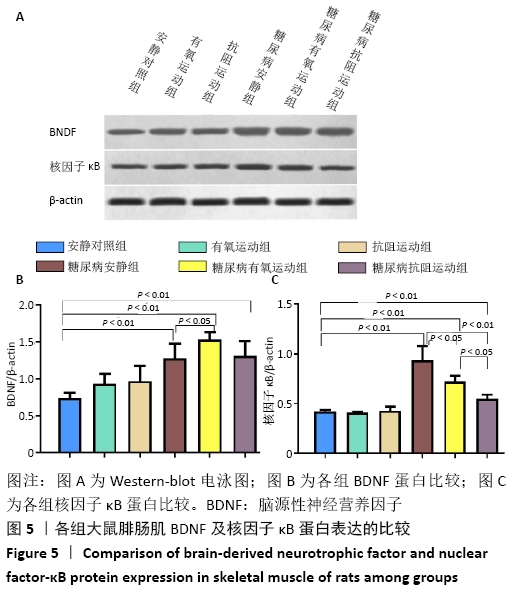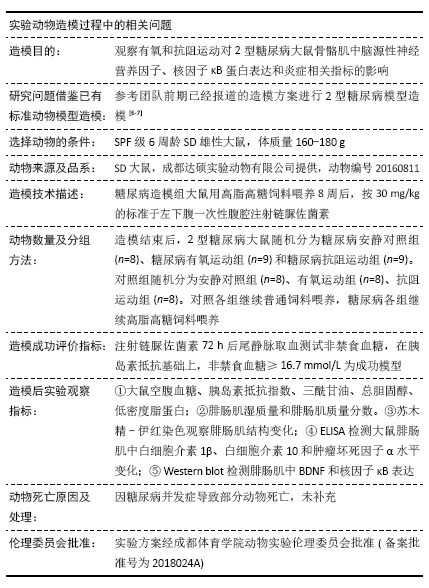中国组织工程研究 ›› 2022, Vol. 26 ›› Issue (5): 669-675.doi: 10.12307/2022.109
• 组织构建实验造模 experimental modeling in tissue construction • 上一篇 下一篇
有氧和抗阻运动干预2型糖尿病大鼠骨骼肌脑源性神经营养因子、核因子κB及炎症指标的表达
税晓平1,2,李春莹3,李顺昌4,孙君志4,苏全生4
- 1四川中医药高等专科学校,四川省绵阳市 621000;2绵阳市骨科医院,四川省绵阳市 621000;3绵阳市中医医院,四川省绵阳市 621000;4成都体育学院运动医学与健康学院,四川省成都市 610041
Effects of aerobic and resistance exercises on brain-derived neurotrophic factor, nuclear factor-kappa B and inflammatory cytokines in skeletal muscle of type II diabetic rats
Shui Xiaoping1, 2, Li Chunying3, Li Shunchang4, Sun Junzhi4, Su Quansheng4
- 1Sichaun College of Traditional Chinese Medicine, Mianyang 621000, Sichuan Province, China; 2Mianyang Osteological Hospital, Mianyang 621000, Sichuan Province, China; 3Mianyang Hospital of Traditional Chinese Medicine, Mianyang 621000, Sichuan Province, China; 4College of Sports Medicine and Health, Chengdu Sport University, Chengdu 610041, Sichuan Province, China
摘要:
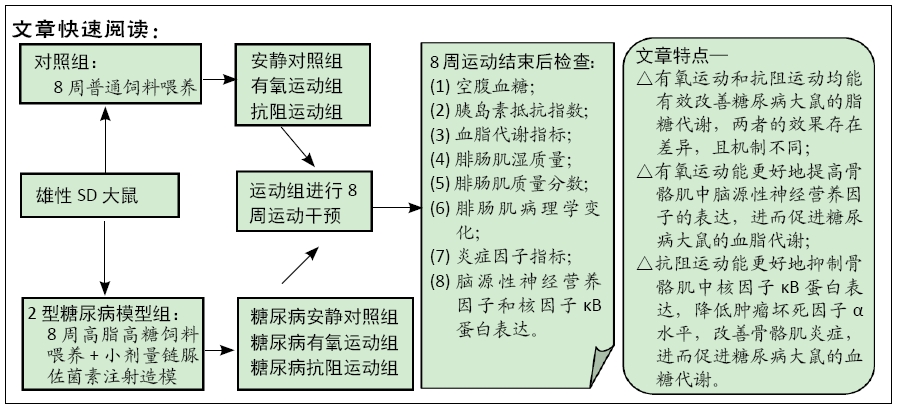
文题释义:
糖尿病骨骼肌病变:是糖尿病并发症之一,将导致骨骼肌慢性炎症状态,出现骨骼肌萎缩和骨骼肌胰岛素抵抗,影响骨骼肌的能量代谢。
骨骼肌源性脑源性神经营养因子:骨骼肌也可分泌脑源性神经营养因子,该蛋白参与了骨骼肌的能量代谢过程。其中骨骼肌内的脑源性神经营养因子参与骨骼肌的脂肪代谢,并通过旁分泌的作用形式参与血糖代谢。
目的:观察有氧运动和抗阻运动对2型糖尿病大鼠骨骼肌中脑源性神经营养因子、核因子κB蛋白表达和炎症相关指标的影响。
方法:高脂高糖联合小剂量链脲佐菌素诱导的2型糖尿病大鼠随机分为糖尿病安静组、糖尿病有氧运动组和糖尿病抗阻运动组,对照组大鼠随机分为安静对照组、有氧运动组、抗阻运动组。各运动组分别进行8周有氧运动或抗阻运动,运动结束后检测各组大鼠空腹血糖、胰岛素抵抗指数、三酰甘油、总胆固醇、低密度脂蛋白、腓肠肌湿质量和质量分数;苏木精-伊红染色观察腓肠肌结构变化;ELISA检测大鼠腓肠肌中白细胞介素1β、白细胞介素10和肿瘤坏死因子α水平;Western blot检测腓肠肌中脑源性神经营养因子、核因子κB的表达。
结果与结论:①与安静对照组比较,糖尿病各组大鼠血脂和血糖指标均显著升高;骨骼肌湿质量减轻,镜检显示骨骼肌萎缩和炎症病变;骨骼肌中核因子κB表达增加,其下游炎症因子肿瘤坏死因子α水平增加;骨骼肌中脑源性神经营养因子蛋白表达明显升高;②8周运动结束后,与糖尿病安静组相比,2个糖尿病运动组血脂和血糖指标均显著下降,骨骼肌中炎症细胞浸润、萎缩变性等病变程度减轻,腓肠肌湿质量和质量分数增加,骨骼肌中核因子κB和肿瘤坏死因子α水平降低,糖尿病有氧运动组脑源性神经营养因子蛋白表达明显升高;③与糖尿病有氧运动组比,糖尿病抗阻运动组大鼠空腹血糖及骨骼肌中核因子κB的表达显著降低(P < 0.05),腓肠肌湿质量和肌质量分数明显升高(P < 0.05);但糖尿病有氧运动组大鼠血脂指标显著低于糖尿病抗阻运动组(P < 0.05,P < 0.01);④结果说明:两种运动均能有效改善糖尿病大鼠的脂糖代谢,其中有氧运动能更好地提高糖尿病大鼠骨骼肌中脑源性神经营养因子表达,更好地改善血脂代谢;抗阻运动能更好地抑制糖尿病大鼠腓肠肌中核因子κB蛋白表达,降低肿瘤坏死因子α水平,改善骨骼肌炎症情况,更好地改善糖尿病大鼠血糖水平。
缩略语:脑源性神经营养因子:brain-derived neurotrophic factor,BDNF
https://orcid.org/0000-0002-9106-0919 (税晓平)
中国组织工程研究杂志出版内容重点:组织构建;骨细胞;软骨细胞;细胞培养;成纤维细胞;血管内皮细胞;骨质疏松;组织工程
中图分类号:
